Pourya Shamsolmoali
From Missing Pieces to Masterpieces: Image Completion with Context-Adaptive Diffusion
Apr 19, 2025Abstract:Image completion is a challenging task, particularly when ensuring that generated content seamlessly integrates with existing parts of an image. While recent diffusion models have shown promise, they often struggle with maintaining coherence between known and unknown (missing) regions. This issue arises from the lack of explicit spatial and semantic alignment during the diffusion process, resulting in content that does not smoothly integrate with the original image. Additionally, diffusion models typically rely on global learned distributions rather than localized features, leading to inconsistencies between the generated and existing image parts. In this work, we propose ConFill, a novel framework that introduces a Context-Adaptive Discrepancy (CAD) model to ensure that intermediate distributions of known and unknown regions are closely aligned throughout the diffusion process. By incorporating CAD, our model progressively reduces discrepancies between generated and original images at each diffusion step, leading to contextually aligned completion. Moreover, ConFill uses a new Dynamic Sampling mechanism that adaptively increases the sampling rate in regions with high reconstruction complexity. This approach enables precise adjustments, enhancing detail and integration in restored areas. Extensive experiments demonstrate that ConFill outperforms current methods, setting a new benchmark in image completion.
Beyond Patches: Mining Interpretable Part-Prototypes for Explainable AI
Apr 16, 2025Abstract:Deep learning has provided considerable advancements for multimedia systems, yet the interpretability of deep models remains a challenge. State-of-the-art post-hoc explainability methods, such as GradCAM, provide visual interpretation based on heatmaps but lack conceptual clarity. Prototype-based approaches, like ProtoPNet and PIPNet, offer a more structured explanation but rely on fixed patches, limiting their robustness and semantic consistency. To address these limitations, a part-prototypical concept mining network (PCMNet) is proposed that dynamically learns interpretable prototypes from meaningful regions. PCMNet clusters prototypes into concept groups, creating semantically grounded explanations without requiring additional annotations. Through a joint process of unsupervised part discovery and concept activation vector extraction, PCMNet effectively captures discriminative concepts and makes interpretable classification decisions. Our extensive experiments comparing PCMNet against state-of-the-art methods on multiple datasets show that it can provide a high level of interpretability, stability, and robustness under clean and occluded scenarios.
HalluShift: Measuring Distribution Shifts towards Hallucination Detection in LLMs
Apr 13, 2025



Abstract:Large Language Models (LLMs) have recently garnered widespread attention due to their adeptness at generating innovative responses to the given prompts across a multitude of domains. However, LLMs often suffer from the inherent limitation of hallucinations and generate incorrect information while maintaining well-structured and coherent responses. In this work, we hypothesize that hallucinations stem from the internal dynamics of LLMs. Our observations indicate that, during passage generation, LLMs tend to deviate from factual accuracy in subtle parts of responses, eventually shifting toward misinformation. This phenomenon bears a resemblance to human cognition, where individuals may hallucinate while maintaining logical coherence, embedding uncertainty within minor segments of their speech. To investigate this further, we introduce an innovative approach, HalluShift, designed to analyze the distribution shifts in the internal state space and token probabilities of the LLM-generated responses. Our method attains superior performance compared to existing baselines across various benchmark datasets. Our codebase is available at https://github.com/sharanya-dasgupta001/hallushift.
Fractional Correspondence Framework in Detection Transformer
Mar 06, 2025



Abstract:The Detection Transformer (DETR), by incorporating the Hungarian algorithm, has significantly simplified the matching process in object detection tasks. This algorithm facilitates optimal one-to-one matching of predicted bounding boxes to ground-truth annotations during training. While effective, this strict matching process does not inherently account for the varying densities and distributions of objects, leading to suboptimal correspondences such as failing to handle multiple detections of the same object or missing small objects. To address this, we propose the Regularized Transport Plan (RTP). RTP introduces a flexible matching strategy that captures the cost of aligning predictions with ground truths to find the most accurate correspondences between these sets. By utilizing the differentiable Sinkhorn algorithm, RTP allows for soft, fractional matching rather than strict one-to-one assignments. This approach enhances the model's capability to manage varying object densities and distributions effectively. Our extensive evaluations on the MS-COCO and VOC benchmarks demonstrate the effectiveness of our approach. RTP-DETR, surpassing the performance of the Deform-DETR and the recently introduced DINO-DETR, achieving absolute gains in mAP of +3.8% and +1.7%, respectively.
TD-Paint: Faster Diffusion Inpainting Through Time Aware Pixel Conditioning
Oct 11, 2024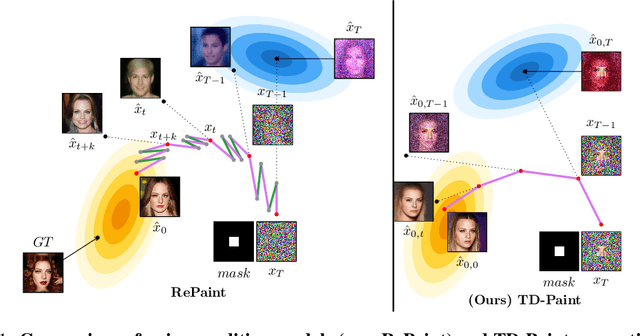

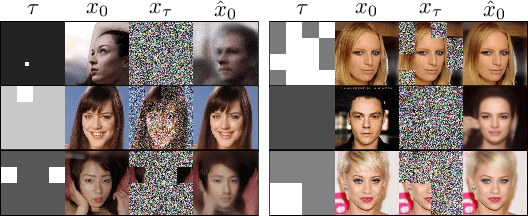

Abstract:Diffusion models have emerged as highly effective techniques for inpainting, however, they remain constrained by slow sampling rates. While recent advances have enhanced generation quality, they have also increased sampling time, thereby limiting scalability in real-world applications. We investigate the generative sampling process of diffusion-based inpainting models and observe that these models make minimal use of the input condition during the initial sampling steps. As a result, the sampling trajectory deviates from the data manifold, requiring complex synchronization mechanisms to realign the generation process. To address this, we propose Time-aware Diffusion Paint (TD-Paint), a novel approach that adapts the diffusion process by modeling variable noise levels at the pixel level. This technique allows the model to efficiently use known pixel values from the start, guiding the generation process toward the target manifold. By embedding this information early in the diffusion process, TD-Paint significantly accelerates sampling without compromising image quality. Unlike conventional diffusion-based inpainting models, which require a dedicated architecture or an expensive generation loop, TD-Paint achieves faster sampling times without architectural modifications. Experimental results across three datasets show that TD-Paint outperforms state-of-the-art diffusion models while maintaining lower complexity.
Source-Free Domain Adaptation of Weakly-Supervised Object Localization Models for Histology
Apr 29, 2024Abstract:Given the emergence of deep learning, digital pathology has gained popularity for cancer diagnosis based on histology images. Deep weakly supervised object localization (WSOL) models can be trained to classify histology images according to cancer grade and identify regions of interest (ROIs) for interpretation, using inexpensive global image-class annotations. A WSOL model initially trained on some labeled source image data can be adapted using unlabeled target data in cases of significant domain shifts caused by variations in staining, scanners, and cancer type. In this paper, we focus on source-free (unsupervised) domain adaptation (SFDA), a challenging problem where a pre-trained source model is adapted to a new target domain without using any source domain data for privacy and efficiency reasons. SFDA of WSOL models raises several challenges in histology, most notably because they are not intended to adapt for both classification and localization tasks. In this paper, 4 state-of-the-art SFDA methods, each one representative of a main SFDA family, are compared for WSOL in terms of classification and localization accuracy. They are the SFDA-Distribution Estimation, Source HypOthesis Transfer, Cross-Domain Contrastive Learning, and Adaptively Domain Statistics Alignment. Experimental results on the challenging Glas (smaller, breast cancer) and Camelyon16 (larger, colon cancer) histology datasets indicate that these SFDA methods typically perform poorly for localization after adaptation when optimized for classification.
Bidirectional Multi-Step Domain Generalization for Visible-Infrared Person Re-Identification
Mar 16, 2024



Abstract:A key challenge in visible-infrared person re-identification (V-I ReID) is training a backbone model capable of effectively addressing the significant discrepancies across modalities. State-of-the-art methods that generate a single intermediate bridging domain are often less effective, as this generated domain may not adequately capture sufficient common discriminant information. This paper introduces the Bidirectional Multi-step Domain Generalization (BMDG), a novel approach for unifying feature representations across diverse modalities. BMDG creates multiple virtual intermediate domains by finding and aligning body part features extracted from both I and V modalities. Indeed, BMDG aims to reduce the modality gaps in two steps. First, it aligns modalities in feature space by learning shared and modality-invariant body part prototypes from V and I images. Then, it generalizes the feature representation by applying bidirectional multi-step learning, which progressively refines feature representations in each step and incorporates more prototypes from both modalities. In particular, our method minimizes the cross-modal gap by identifying and aligning shared prototypes that capture key discriminative features across modalities, then uses multiple bridging steps based on this information to enhance the feature representation. Experiments conducted on challenging V-I ReID datasets indicate that our BMDG approach outperforms state-of-the-art part-based models or methods that generate an intermediate domain from V-I person ReID.
SeTformer is What You Need for Vision and Language
Jan 07, 2024


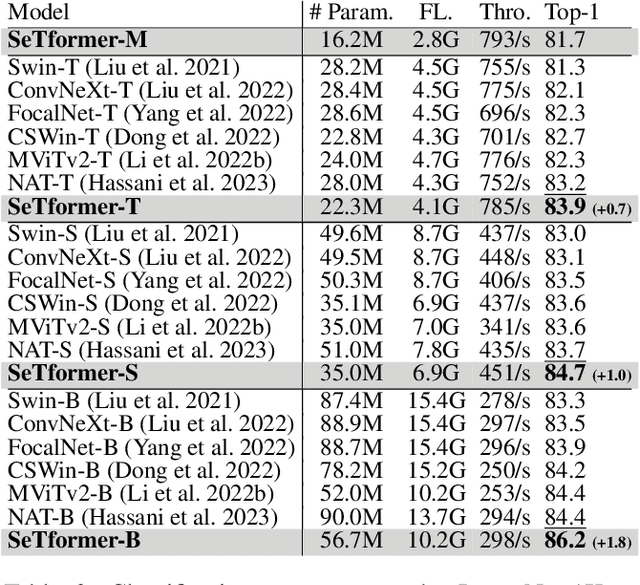
Abstract:The dot product self-attention (DPSA) is a fundamental component of transformers. However, scaling them to long sequences, like documents or high-resolution images, becomes prohibitively expensive due to quadratic time and memory complexities arising from the softmax operation. Kernel methods are employed to simplify computations by approximating softmax but often lead to performance drops compared to softmax attention. We propose SeTformer, a novel transformer, where DPSA is purely replaced by Self-optimal Transport (SeT) for achieving better performance and computational efficiency. SeT is based on two essential softmax properties: maintaining a non-negative attention matrix and using a nonlinear reweighting mechanism to emphasize important tokens in input sequences. By introducing a kernel cost function for optimal transport, SeTformer effectively satisfies these properties. In particular, with small and basesized models, SeTformer achieves impressive top-1 accuracies of 84.7% and 86.2% on ImageNet-1K. In object detection, SeTformer-base outperforms the FocalNet counterpart by +2.2 mAP, using 38% fewer parameters and 29% fewer FLOPs. In semantic segmentation, our base-size model surpasses NAT by +3.5 mIoU with 33% fewer parameters. SeTformer also achieves state-of-the-art results in language modeling on the GLUE benchmark. These findings highlight SeTformer's applicability in vision and language tasks.
Efficient Object Detection in Optical Remote Sensing Imagery via Attention-based Feature Distillation
Oct 28, 2023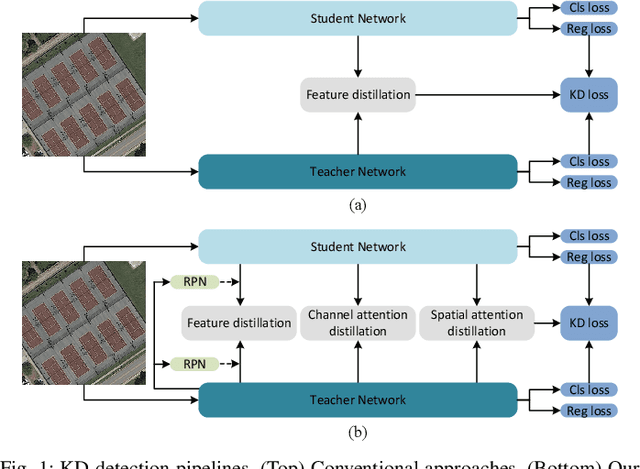
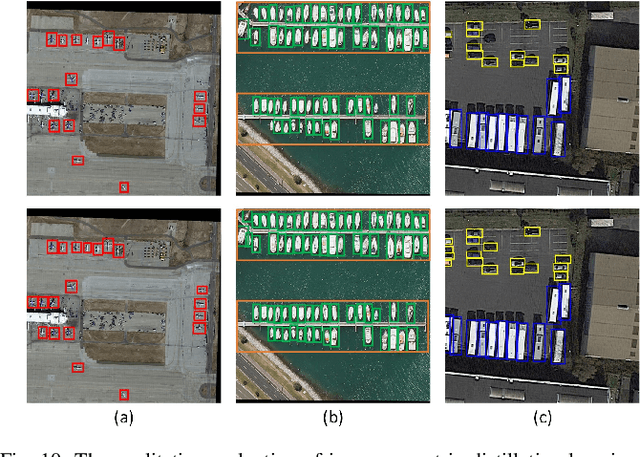
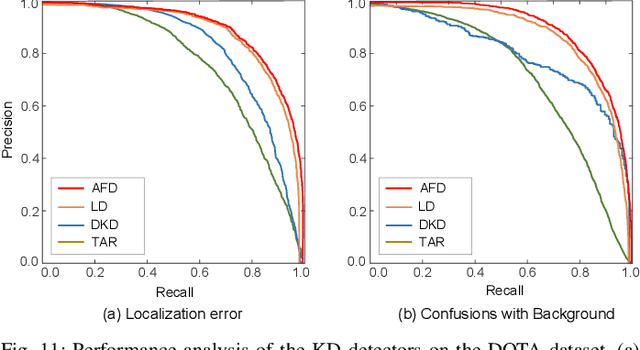
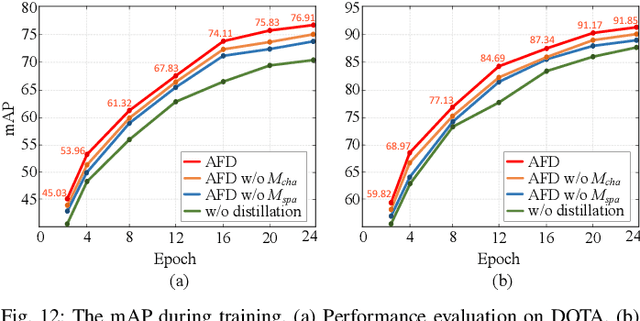
Abstract:Efficient object detection methods have recently received great attention in remote sensing. Although deep convolutional networks often have excellent detection accuracy, their deployment on resource-limited edge devices is difficult. Knowledge distillation (KD) is a strategy for addressing this issue since it makes models lightweight while maintaining accuracy. However, existing KD methods for object detection have encountered two constraints. First, they discard potentially important background information and only distill nearby foreground regions. Second, they only rely on the global context, which limits the student detector's ability to acquire local information from the teacher detector. To address the aforementioned challenges, we propose Attention-based Feature Distillation (AFD), a new KD approach that distills both local and global information from the teacher detector. To enhance local distillation, we introduce a multi-instance attention mechanism that effectively distinguishes between background and foreground elements. This approach prompts the student detector to focus on the pertinent channels and pixels, as identified by the teacher detector. Local distillation lacks global information, thus attention global distillation is proposed to reconstruct the relationship between various pixels and pass it from teacher to student detector. The performance of AFD is evaluated on two public aerial image benchmarks, and the evaluation results demonstrate that AFD in object detection can attain the performance of other state-of-the-art models while being efficient.
Distance Weighted Trans Network for Image Completion
Oct 25, 2023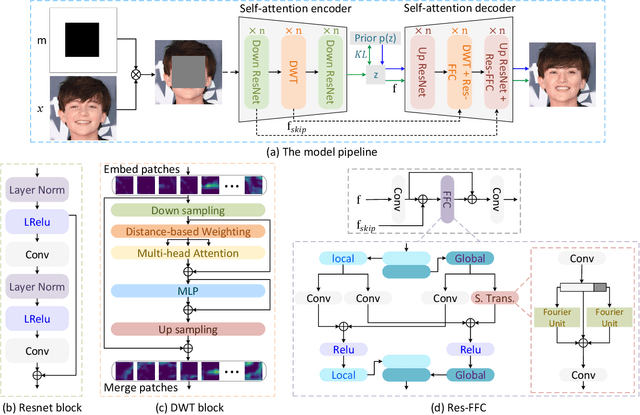
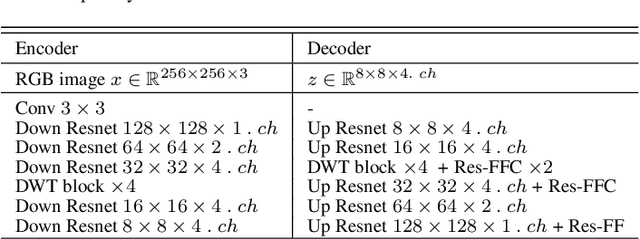
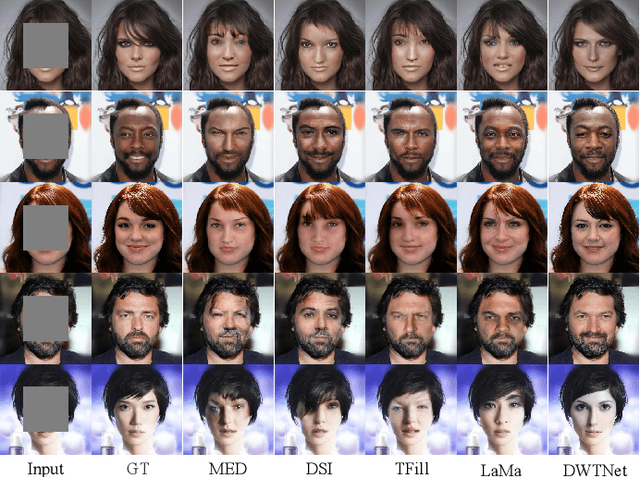

Abstract:The challenge of image generation has been effectively modeled as a problem of structure priors or transformation. However, existing models have unsatisfactory performance in understanding the global input image structures because of particular inherent features (for example, local inductive prior). Recent studies have shown that self-attention is an efficient modeling technique for image completion problems. In this paper, we propose a new architecture that relies on Distance-based Weighted Transformer (DWT) to better understand the relationships between an image's components. In our model, we leverage the strengths of both Convolutional Neural Networks (CNNs) and DWT blocks to enhance the image completion process. Specifically, CNNs are used to augment the local texture information of coarse priors and DWT blocks are used to recover certain coarse textures and coherent visual structures. Unlike current approaches that generally use CNNs to create feature maps, we use the DWT to encode global dependencies and compute distance-based weighted feature maps, which substantially minimizes the problem of visual ambiguities. Meanwhile, to better produce repeated textures, we introduce Residual Fast Fourier Convolution (Res-FFC) blocks to combine the encoder's skip features with the coarse features provided by our generator. Furthermore, a simple yet effective technique is proposed to normalize the non-zero values of convolutions, and fine-tune the network layers for regularization of the gradient norms to provide an efficient training stabiliser. Extensive quantitative and qualitative experiments on three challenging datasets demonstrate the superiority of our proposed model compared to existing approaches.
 Add to Chrome
Add to Chrome Add to Firefox
Add to Firefox Add to Edge
Add to Edge